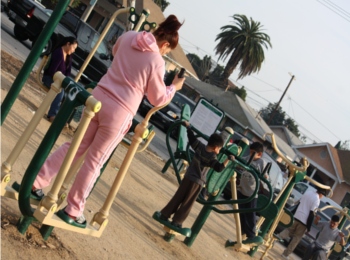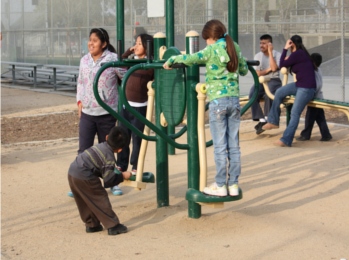
It was a warm day, but despite the glaring sun, they settled in the area of the park that was the most exposed.
Situated in a 1,200 square foot zone, nine pieces of exercise equipment stood on decomposed, golden granite.
Jimenez’s son struggled to maneuver on an aerobic machine meant for those several years older, her husband worked up a sweat on the zone’s elliptical, and Jimenez walked between the nine machines, testing each one briefly.
For Jimenez, trips to the parks have become part of her daily schedule thanks to the “fitness zone.”
“Two weeks ago, I walked around and I saw these machines,” she said. “I think, ‘I’m going to come,’ and I’m here almost every day, twice a day.”
Jimenez is not alone.
On Jan. 16, Los Angeles City Councilwoman Jan Perry dedicated the first of six fitness zones in South Los Angeles.
The fitness zones include weather-resistant exercise equipment for strength training and aerobic exercise.
The Trust for Public Land received funding from Kaiser Permanente’s Healthy Eating, Active Living grants of $900,000 to be spent over three years for this equipment, as part of a park revitalization project.
The Community Redevelopment Agency of Los Angeles also provided funding.

“[People are] on them the second the crew is done installing them,” said Pascaline Derrick, a project manager at the Trust for Public Land. “There’s usually people standing around waiting for their completion.”
And their popularity has not waned.
“I have personally come by here twice since we’ve had them up and operating early in the morning, and I’ve seen 20, 30, 40 people at a time,” said Mark Mariscal, the superintendent for the Pacific Region of the Los Angeles Department of Recreation and Parks.
George Zimmerman works out at a fitness zone three to four times a week. The 76-year-old South Los Angeles resident uses the equipment to strengthen his legs.
“With the kind of equipment they have here, I don’t have to go and get a membership at some club,” Zimmerman said. “You catch a lot of people who are overweight, need the exercise and can’t afford to go to a gym, so this is a convenience that we all need really.”
Mariscal estimated that the park usage has increased 300 to 400 percent since the zone’s installation and predicted that it will continue to grow.
Perry credited this overwhelming usage to the zones’ accessibility.
“They are easy to use, and anyone of any ability can get on there,” Perry said. “You don’t have to be in shape to get in shape.
“And they are actually fun.”
This ease of use is due to the isometric weight resistance of the machines. The equipment employs its users’ body weight to engage nine muscle groups.
But the zones’ accessibility extends beyond the equipment.
The Trust for Public Land chose the locations of the fitness zones because of their accessibility to parking and park resources.
In several parks, the zones reside next to playgrounds, encouraging parents to exercise while their children play.
“The parent and the child are both outdoors, exercising, really getting out of the chair, not watching TV… and they’re out doing physical activity which is great,” said Mariscal.
Many zones are placed within sight of the park administrative offices to address safety concerns.
Michael Goran, a professor in preventative medicine at the Keck School of Medicine’s Center for Childhood Obesity, said safety is a key consideration when assessing the success of the fitness zones.
“If they are in areas that are perceived to be safe, this could be a great help [in combating obesity],” Goran said. “You’d have to increase physical activity quite a bit to get any effects … you need to design the resource to make it more accessible to the public.”

Goran said the obesity rate is between 50 and 60 percent in communities of color. He estimated that rate is even higher in South Los Angeles.
In South Los Angeles’s 90007 and 90011 zip codes, up to 37 percent of children are overweight. That percentage soars to 54 percent when it comes to children who are not physically fit, according to the Healthy Eating Active Communities project.
Mariscal said these childhood obesity rates have tripled in the past 20 years.
“We see it at our rec centers, where we see a lot of inactivity from kids,” Mariscal said. He noted that some children are not able to complete the walk from school to the recreation centers without “huffing and puffing.”
“We’ve placed [the fitness zones] in places of high need where we have a big population of residents who are obese and who have diabetes and hypertension,” Derrick said.
The Trust for Public Land’s consideration of South Los Angeles proves a great resource for the area, said Perry.
“We are battling disproportionate statistics on obesity,” Perry said. “But this is an opportunity for South L.A. to address these issues in an upbeat and positive way and as a family.”
This story is part of a collaboration between KPCC.org and Intersections: The South Los Angeles Report.
Photo credit: Christine Trang














